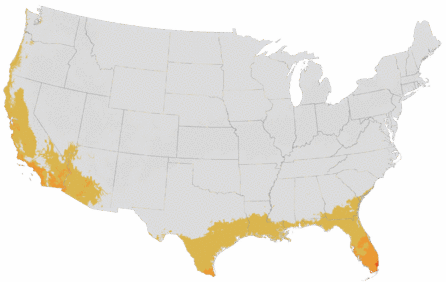You're growing in this Zip Code:
Change LocationDiscover Plants for Your Area
Radiation Bush Lantana
Lantana camara 'Radiation'
We no longer grow this plant
Be Inspired: How to Use this Plant
| Bloom Time | Spring and summer; longer in frost-free areas |
|---|---|
| Deciduous/Evergreen | Evergreen |
| Special Features | Easy Care, Waterwise, Benefits Birds |
| Problems/Solutions | Coastal Exposure, Deer Resistant, Erosion Control, Tolerates Urban Pollution |
| Growth Rate | Moderate |
| Growth Habit | Upright |
| Flower Attributes | Long Bloom Season, Showy Flowers |
| Landscape Use | Border, Container, Hillside |
| Design Ideas | This vivid Lantana is an unparalleled source of quick foliage and flowers in warmer climates. Its coloring is just right for adding brilliance to the tropical-inspired landscape that will take some cold. These plants grow very fast to fill in a young landscape, or use as a single-season makeover plant. Very resilient in extreme heat, particularly reflected heat off driveways or street paving. A natural for filling sunny banks and slopes. Plant in flower and shrub beds, raised planters, along fence lines and foundations, and in parkways. Put them in pots for powerful color on a deck or patio with brightly blooming annual flowers. |
| Flower Color | Multicolored |
| Foliage Color | Green |
| Companion Plants | Maiden Grass (Miscanthus); Salvia (Salvia); Heliotrope (Heliotrope); Red Yucca (Hesperaloe); Hibiscus (Hibiscus); Cordyline (Cordyline) |
| Care Instructions | Thrives in average, well-drained soils. Water deeply, regularly in first growing season to establish root system. Once established in the landscape, reduce frequency; continue to water container plants regularly. Fertilize in spring. Remove spent blooms periodically and prune annually to shape. |
| Lore | Lantanas are valuable butterfly nectar plants and are equally appealing to hummingbirds. This is a large genus with over 150 species native to tropical regions of the Americas and Africa. L. camara is native as far north as Texas and southern Georgia but has naturalized elsewhere in the South. The genus name is the same as the South American name for the plants. Many of the contemporary varieties resulted from hybrids of this and L. montevidensis. |
| Bloom Time | Spring and summer; longer in frost-free areas |
|---|---|
| Deciduous/Evergreen | Evergreen |
| Special Features | Easy Care, Waterwise, Benefits Birds |
| Problems/Solutions | Coastal Exposure, Deer Resistant, Erosion Control, Tolerates Urban Pollution |
| Growth Rate | Moderate |
| Growth Habit | Upright |
| Flower Attributes | Long Bloom Season, Showy Flowers |
We no longer grow this plant
We no longer grow this plant
Buy Online
This plant is not available to purchase online.
We no longer grow this plant. For replacement suggestions, check out the plants “You May Also Like” below.
About Us
We have been pioneers and craftsmen in the art of growing plants for nearly
100 years. Since our founding in Southern California by Harry E. Rosedale, Sr.
in 1926, we have been absolutely dedicated and obsessed with quality.
We have been pioneers and craftsmen in the art of growing plants for nearly 100 years. Since our founding in Southern California by Harry E. Rosedale, Sr. in 1926, we have been absolutely dedicated and obsessed with quality.








